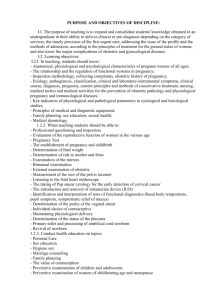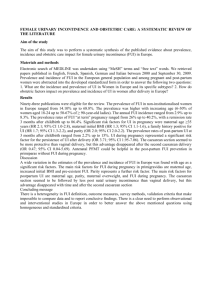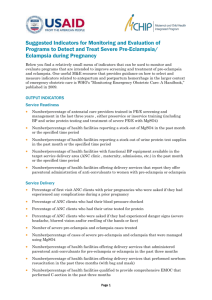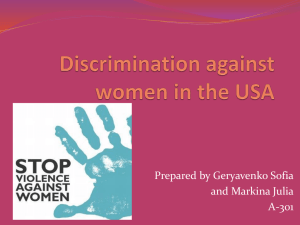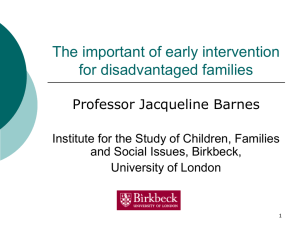Introduction to UKOSS presentation
advertisement
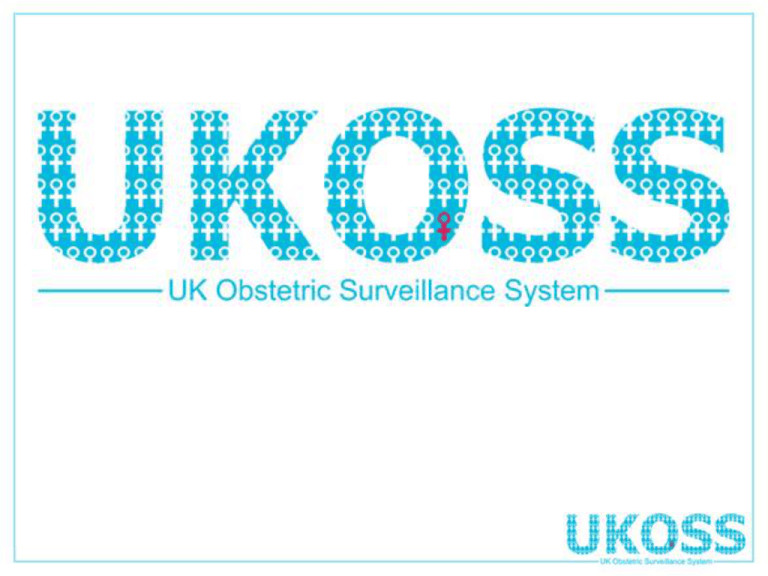
The Pyramid of Disease Deaths Severe Morbidity Illness requiring medical care Asymptomatic/ Self-care Rare Obstetric Disorders – Why are they important? • Individually uncommon, together a considerable burden • Difficult to study, under researched • Clinical practice rarely based on robust evidence • “Near-miss” events “Near-miss” events “a severe life-threatening obstetric complication necessitating urgent medical intervention in order to prevent likely death of the mother”* • In countries where deaths are rare – Events associated with death may be atypical – Study of “near-miss” events may give more insight into risk factors and possible means of prevention *Filippi V, Ronsmans C et al. Stud Fam Plann. 2000 31(4):309-24 Leading causes of direct deaths reported to CEMACH 2003-5 Thromboembolism Hypertension Sepsis Amniotic fluid embolism Haemorrhage Ectopic Anaesthetic Other direct Other early pregnancy deaths 0 Source: Saving Mothers’ Lives 2003-5, Table 1.3 5 10 Rate per million maternities 15 20 UK Obstetric Surveillance System (UKOSS) • Monthly prospective case collection from obstetrician, midwife, obstetric anaesthetist and risk midwife (individualised by hospital) • Cohort or case control studies conducted as well as descriptive studies • Rolling programme of studies • Central data collection The UKOSS Reporting Card Data Collection Forms • • • • • Different for each study No identifiable information requested Completed from medical notes only Content controlled Forms may be sent again after delivery Data Feedback • • • • • Quarterly newsletters Annual report Peer-reviewed publications Conference presentations UKOSS website – http://www.npeu.ox.ac.uk/ukoss/ Advantages of UKOSS • Can be used for a variety of studies • Lessens the burden of multiple requests for information from individual clinicians • Information used to make practical improvements in prevention, treatment and service planning • Studies can be rapidly introduced in response to conditions of emerging public health importance UKOSS Card Return Rates 100 90 Percentage of cards returned 80 70 60 50 40 30 20 10 0 Month What conditions can be studied using UKOSS? • Disorder is an important cause of perinatal or maternal morbidity or mortality • Uncommon (<1 per 2000 births) • UKOSS methodology is suitable • Other data sources exist to assess or enhance ascertainment Study Application Procedure • Informal discussion with Clinical Coordinator • Outline applications discussed at management group (monthly) • Full applications discussed by Steering Committee (four-monthly meeting) • Investigators invited to attend Steering Committee meeting Completed Studies 2006 2009 • • • • • • Therapies for Peripartum Haemorrhage • Multiple repeat caesarean section • Pregnancy in renal transplant recipients Eclampsia Peripartum Hysterectomy Acute Fatty Liver Antenatal PE TB 2007 • Gastroschisis 2008 • Extreme Obesity • FMAIT 2010 • • • • • • • H1N1v influenza in pregnancy Antenatal Stroke Failed Intubation Malaria Congenital Diaphragmatic Hernia Myocardial Infarction Uterine Rupture Current Studies • • • • • • • • • Amniotic Fluid Embolism Aortic dissection Myeloproliferative disorders Pituitary tumours in pregnancy Placenta Accreta Pulmonary Vascular Disease Obstetric Cholestasis Non-renal Transplant recipients Sickle cell disease Future Studies • In planning – – – – – – HELLP syndrome Epidural haematoma/abscess Pregnancy post laparoscopic gastric band surgery Pregnancy in heart valve recipients Septicaemic shock Pregnancy in women over 48 Uses of UKOSS Data • • • • • • Disease incidence/prevalence Audit of guidelines/change in practice Risk factors Management techniques Public health response Outcomes 1. Incidence - Eclampsia • 214 confirmed cases • Incidence 2.7 per 10,000 (95% CI 2.4-3.1)‡ • Incidence in 1992 4.9 per 10,000 (95% CI 4.5-5.4)*† * p<0.0001 ‡Knight M on behalf of UKOSS 2007 BJOG 114: 1072-1078 and Redman 1994 BMJ 309:1395-1400 †Douglas Risk Reductions Surveys 1992-2005 RCTs Eclampsia Incidence -45% (-53% to -34%) -58%† (-71% to -40%) Recurrent fits -39% (-53% to -21%) -67%‡ (-79% to -47%) -100% (*) -50%‡ (-76% to +5%) Severe morbidity -70% (-80% to -55%) -13% (-29% to +6%) Perinatal deaths +12% (-43% to +117%) -16%‡ (-34% to +7%) Case fatality *Not calculable †Magpie trial Lancet 2002 359: 1877-90 ‡Collaborative Eclampsia trial (Mg vs phenytoin) Lancet 1995 345: 1455-63 2. Guidelines – Antenatal PE • 143 cases identified • 9 women should have received LMWH according to RCOG guidelines – Only 3 (33%) did • 6 women had a PE following LMWH prophylaxis – 3 (50%) received lower than recommended doses – 3 received enoxaparin 40mg once daily Knight M on behalf of UKOSS 2008 BJOG 115: 453-461 3. Risk factors – Peripartum Hysterectomy Risk Factors: Previous Caesarean Section Number Cases (n,%) Controls (n,%) 0 151 (48) 513 (85) Adjusted Odds Ratio (95% CI) 1.0 (ref) 1 80 (25) 76 (13) 2.1 (1.4-3.3) 2+ 84 (27) 14 (2) 18.6 (7.7-45.4) Adjusted OR (any previous CS) = 3.5 (95% CI 2.4-5.3) Risk Summary Category Risk of Requiring Peripartum Hysterectomy Woman undergoing first delivery vaginally 1 in 30,000 Woman undergoing first caesarean section 1 in 1,700 Subsequent delivery in a woman with one previous caesarean section 1 in 1,300 Subsequent delivery in a woman with two or more previous caesarean sections 1 in 220 Knight et al on behalf of UKOSS 2008. Obstet Gynecol 111: 97-105 4. Management – Antivirals for H1N1 Treated within two days Admitted to Not ITU admitted to ITU (n,%) (n,%) Adjusted Odds Ratio (95% CI) Yes 12 (26) 119 (68) 0.1 (0.1-0.3) No 34 (74) 55 (32) 1 Yates, L. et al 2010. Health Technol Assess (in press) 5. Public Health Response – H1N1v influenza in pregnancy Number of cases notified • Pregnant women hospitalised with confirmed H1N1v 40 35 30 25 20 15 10 5 0 35 36 37 38 39 40 41 42 43 44 45 46 47 48 49 50 Week number 6. Outcomes - obesity Obese women n (%) Comparison women n (%) Adjusted OR‡ (95%CI) Preterm delivery 65 (10) 43 (7) 1.6 (1.0-2.4) Induction 241 (37) 147 (23) 2.0 (1.5-2.5) Labour 437 (67) 548 (85) 0.4 (0.3-0.5) Caesarean delivery 328 (50) 140 (22) 3.8 (2.7-4.5) ‡ Adjusted for age, socioeconomic group, parity, ethnicity, smoking Knight et al 2010. Obstet Gynecol 115:989–97 Anaesthetic outcomes Obese women n/N (%) Comparison women n/N (%) Adjusted OR (95% CI) Epidural 32/184 (17) 7/130 (5) 3.1 (1.4-7.1) Spinal 28/189 (13) 2/112 (2) 9.5 (2.2-42.1) CSE 6/43 (12) 0/12 (0) * GA for CS 1/37 (2) 0/7 (0) * Failure or problems with: *Unstable estimate aOR of GA for delivery = 6.4 (2.6-15.3) Summary • UKOSS is a unique national collaboration • The study of rare disorders, including ‘near-miss’ events using UKOSS gives additional value to complement CEMACH information • UKOSS studies can be used to investigate incidence, risk factors, management and outcomes of individual conditions, and audit guidelines • Many of these research questions cannot be answered using any other methodology • UKOSS studies would not be possible without the collaboration of clinicians throughout the UK Acknowledgements • UKOSS reporting clinicians Funding • NIHR NCCRCD • Department of Health Policy Research Programme • NIHR HTA Programme
